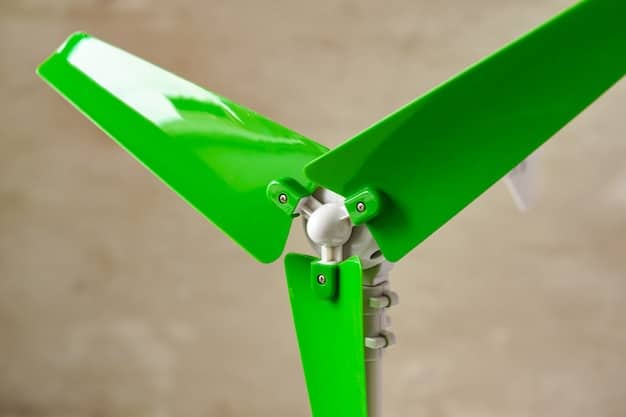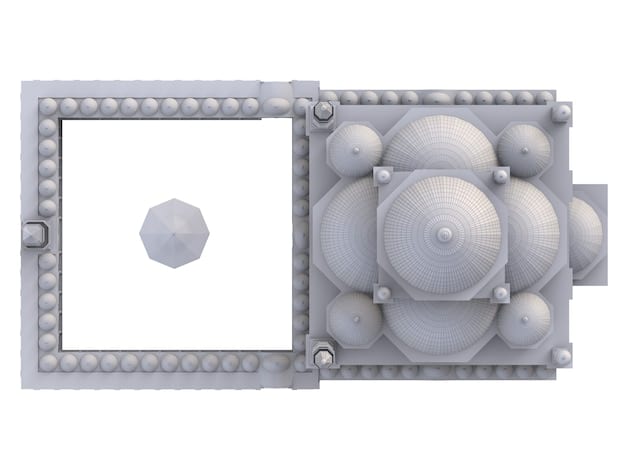3D Printing in Green Energy: Emerging Applications & Innovations

3D printing is revolutionizing green energy infrastructure by enabling the creation of customized components, reducing waste, and accelerating the development of sustainable energy solutions like wind turbines, solar panels, and geothermal systems.
What are the Emerging Applications of 3D Printing in Green Energy Infrastructure? 3D printing, also known as additive manufacturing, is transforming various industries. Notably, its impact on renewable energy is making headlines. From customized components to rapid prototyping, discover how this innovative technology is shaping a greener future.
3D Printing and Renewable Energy: An Introduction
3D printing offers unprecedented design freedom, material efficiency, and speed in manufacturing, which are vital for advancing green energy technologies. Let’s explore beyond the basic concept of 3D printing and see where the real potential lies for improving green energy infrastructure.
The versatility of 3D printing makes it an ideal tool for tackling challenges in the renewable energy sector. By allowing for on-demand production and reducing material waste, it supports more sustainable and efficient energy solutions.
The Basics of 3D Printing
3D printing, or additive manufacturing, involves building three-dimensional objects layer by layer from a digital design. This process allows for complex geometries and customized designs, offering significant advantages over traditional manufacturing methods.
Within the scope of renewable energy, 3D printing enables engineers to create parts and components that are lighter, stronger, and more efficient. This technology can lead to improved performance and reduced costs for sustainable energy systems.
- Material Efficiency: One of the significant benefits is less waste.
- Complex Designs: Engineers can create components with intricate geometries.
- Rapid Prototyping: Ideas can be quickly turned into tangible prototypes.
3D printing is not just a tool, but a catalyst for innovation in the green energy space. Its applications span across multiple areas, each offering unique opportunities to enhance existing technologies and strategies.
Wind Energy: Enhancing Turbine Efficiency with 3D Printing

Wind energy is a cornerstone of renewable power generation, and 3D printing is playing a crucial role in optimizing turbine design, materials, and manufacturing processes. The wind sector benefits from the customizability and rapid production capabilities of 3D printing.
By integrating 3D printing, manufacturers can experiment with novel blade designs that maximize energy capture and reduce noise. This enables more effective use of wind resources in different environments.
Custom Blade Design
One of the most significant advantages of using 3D printing in wind energy is the ability to create customized blade designs. These designs can be optimized for different wind conditions, leading to increased energy production.
With 3D printing, it’s possible to produce blades with aerodynamic features that would be difficult or impossible to achieve with traditional manufacturing methods. As a result, wind turbines can operate more efficiently and generate more power.
Reducing Costs and Lead Times
3D printing also helps reduce manufacturing costs and lead times for wind turbine components. By printing parts on demand, manufacturers can avoid the expenses associated with tooling and mass production.
- On-Demand Production: Components are printed as needed.
- Reduced Tooling Costs: No need for expensive molds or dies.
- Faster Iterations: Designs can be quickly modified.
3D printing transforms wind energy by providing greater design flexibility, faster production times, and reduced costs. These benefits make wind power a more competitive and sustainable energy source.
With 3D printing, the wind industry can push the boundaries of turbine technology, enhance performance, and drive down the cost of wind energy, helping to meet growing energy demands in an environmentally responsible manner.
Solar Energy: Innovations in Panel Manufacturing
Solar energy is one of the fastest-growing renewable energy sources, and 3D printing is providing innovative ways to manufacture, install, and enhance solar panels. The future of solar is shaped by these technological possibilities.
3D printing can be used to create customized solar panel frames, connectors, and even the solar cells themselves. This results in more efficient, durable, and affordable solar energy solutions.
3D Printed Solar Cells
Researchers are exploring the possibility of printing solar cells using specialized materials and techniques. Creating solar cells through additive manufacturing has the potential to greatly reduce the cost and complexity of solar panel production.
By 3D printing solar cells, manufacturers can create thin, flexible panels that can be applied to a wider range of surfaces. This opens up new opportunities for integrating solar energy into buildings, vehicles, and other structures.
Customizable Panel Designs
3D printing also enables the creation of customizable solar panel designs to fit specific applications. Panels can be tailored to different shapes, sizes, and power outputs, improving efficiency and aesthetics.
- Thin Film Panels: Printable solar films can be easily added to surfaces.
- Building-Integrated PV: Custom panels can be designed for specific building needs.
- Optimized Performance: Panel designs can be fine-tuned for different climates.
3D printing is revolutionizing solar energy by providing new ways to manufacture solar cells, customize panel designs, and improve efficiency. When these techniques are combined, they bring solar energy to more consumers and promote a more sustainable energy future.
With 3D printing, solar energy can become more accessible, affordable, and adaptable, contributing to a cleaner and more sustainable energy mix worldwide. This technology has the potential to accelerate the transition to a more solar-powered future.
Geothermal Energy: Enhancing Drilling and Well Construction
Geothermal energy, which taps into the Earth’s internal heat, is a reliable source of renewable power. 3D printing has opened innovative pathways in geothermal exploration, drilling, and well construction.
By enabling the creation of customized drilling tools and well components, 3D printing is making geothermal energy extraction more efficient, cost-effective, and environmentally friendly. This supports wider adoption of geothermal technology.
Customized Drilling Tools
3D printing allows for the production of drilling tools tailored to specific geothermal environments. These tools can be designed to withstand high temperatures, pressures, and corrosive conditions, improving drilling efficiency.
With 3D printing, manufacturers can create drill bits with optimized cutting geometries, leading to faster drilling rates and reduced energy consumption. Customized drilling tools can enhance the viability and sustainability of geothermal projects.
Improved Well Components
3D printing can also improve the design and construction of geothermal wells. Manufacturers can print well components with complex internal structures that enhance fluid flow and heat extraction.

- Enhanced Fluid Flow: Complex internal structures improve heat transfer.
- Reduced Corrosion: Specialized materials resist corrosive environments.
- Optimized Performance: Geothermal systems operate more efficiently.
3D printing is positively impacting geothermal energy by enabling the creation of customized drilling tools, designing improved well components, and increasing energy extraction efficiency. All of these combine to make geothermal more competitive and sustainable.
The enhanced capabilities of 3D printing contribute to the growth and sustainability of geothermal energy, pushing it further into becoming a key player in the renewable energy mix. This technology is pivotal for achieving a cleaner and more sustainable energy future.
Energy Storage: Advancements in Battery Design and Manufacturing
Energy storage is essential for integrating renewable energy sources into the grid, and 3D printing is influencing how batteries are designed, manufactured, and deployed. It’s enhancing electrochemical devices.
3D printing enables the creation of customized battery architectures, electrode designs, and packaging solutions. This leads to more efficient, compact, and high-performance energy storage systems.
Custom Battery Architectures
One of the primary advantages of using 3D printing in energy storage is the ability to create tailored battery architectures. 3D printing allows researchers to optimize energy density, power output, and cycle life.
With 3D printing, batteries can be designed in complex geometries to fit specific applications, such as electric vehicles, portable electronics, and grid-scale storage. Tailored architectures enhance energy storage capabilities.
Electrode Optimization
3D printing helps optimize electrode materials and structures within batteries. This enables the creation of electrodes with increased surface area, enhanced conductivity, and improved ion transport.
- High Surface Area: Optimized electrode structures maximizes charge transfer.
- Enhanced Conductivity: Increased conductivity improves battery performance.
- Improved Ion Transport: Facilitating ion flow enhances battery efficiency.
The impact of 3D printing on energy storage is transformative, offering customized battery designs, electrode optimization, and advanced materials integration. When working together, these contribute to higher-performance and more sustainable energy storage solutions.
The advances in 3D printing are helping to overcome the challenges facing renewable energy integration, transforming it into a reliable and sustainable energy source. As technology evolves, the role of 3D printing in energy storage will continue to expand, contributing to a greener future.
Sustainable Materials in 3D Printing for Green Energy
The materials used in 3D printing play a critical role in their environmental impact and sustainability. Innovations in sustainable materials enhance the green credentials of 3D printing applications for green energy.
Materials made from recycled plastics, bio-based composites, and other eco-friendly resources are increasingly used in 3D printing for green energy components. This reduces carbon footprint and promotes a circular economy.
Recycled Plastics
Using recycled plastics as feedstock for 3D printing is a sustainable approach that reduces waste and lowers dependence on virgin materials. Recycled plastics can be used to create a variety of components for renewable energy systems.
By using recycled plastics, manufacturers can reduce greenhouse gas emissions, conserve resources, and promote a circular economy. Recycled materials also offer cost benefits.
Bio-Based Composites
Bio-based composites, made from natural fibers and resins, are another sustainable option for 3D printing in green energy. These materials are renewable and biodegradable, providing an environmentally friendly alternative to traditional plastics.
- Renewable: Bio-based materials are from renewable sources.
- Biodegradable: These offer end-of-life advantages.
- Lower Carbon Footprint: Bio-composites have a reduced impact on the environment.
3D printing with sustainable materials is an essential component of the green energy revolution, offering an eco-friendly and resource-efficient way to produce renewable energy components. When combined, these techniques make the industry more resilient.
By promoting the use of sustainable materials, the integration of 3D printing in green energy reduces environmental impact and fosters a more circular and sustainable approach to manufacturing. This direction is indispensable for creating a truly green energy infrastructure.
| Key Point | Brief Description |
|---|---|
| 🌬️ Wind Turbine Blades | Custom designs increase efficiency and reduce costs. |
| ☀️ Solar Panel Manufacturing | Enables customizable and efficient solar cell production. |
| 🌍 Geothermal Enhancements | Improves drilling tools and well construction for better energy extraction. |
| 🔋 Battery Design | Offers custom designs for energy density and performance optimization. |
FAQ Section
▼
3D printing, or additive manufacturing, builds objects layer by layer from a digital design. It uses materials like plastics, metals, or composites to create three-dimensional objects, offering design freedom, speed, and efficiency.
▼
3D printing enables the creation of customized wind turbine blades optimized for specific wind conditions. This leads to increased energy capture, reduced noise, and lowers manufacturing costs through efficient, on-demand production.
▼
Yes, 3D printing allows for customizable solar panel designs and the production of thin, flexible solar cells that can be applied to various surfaces. This improves efficiency, durability, and opens up new possibilities for solar applications.
▼
3D printing facilitates the creation of customized drilling tools and improved well components tailored to specific geothermal environments. These innovations make geothermal energy extraction more efficient, cost-effective, and sustainable.
▼
3D printing allows for the design of customized battery architectures and the optimization of electrode materials and structures. This results in more efficient, compact, and high-performance energy storage systems necessary for grid integration.
Conclusion
As we’ve explored, 3D printing is set to revolutionize green energy infrastructure, from enhancing wind turbine efficiency to advancing solar panel manufacturing, optimizing geothermal energy extraction, and revolutionizing energy storage solutions. By embracing these innovations, the green energy sector can achieve greater sustainability, efficiency, and cost-effectiveness, paving the way for a cleaner, more resilient energy landscape.





